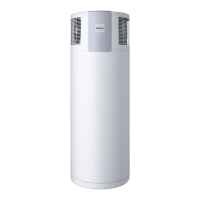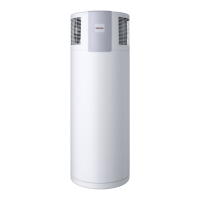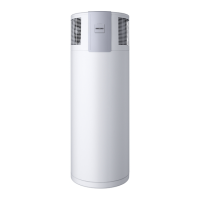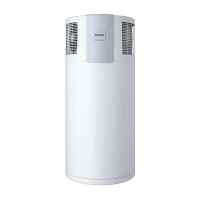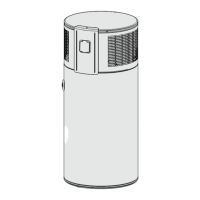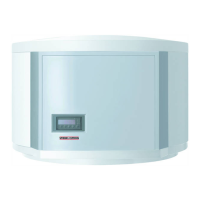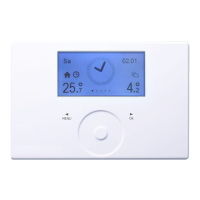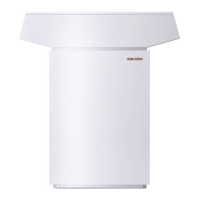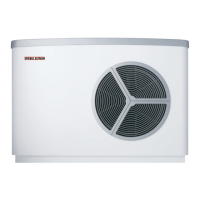www.stiebel-eltron.com WWK222-302 H | 5
WARNING Burns
The water in the DHW cylinder can be heated to temper-
atures in excess of 60°C. There is a risk of scalding at
outlet temperatures in excess of 43 °C.
Ensure you do not come into contact with the water
when discharged.
WARNING Burns
Touching hot components can lead to burns.
When working on hot components, always wear
protective working clothing and safety gloves.
The pipework connected to the DHW outlet of the appli-
ance can reach temperatures in excess of 60°C.
WARNING Burns
The appliance is filled with refrigerant at the factory.
In the event of refrigerant escaping due to a leak, avoid
coming into contact with the refrigerant or inhaling the
released vapours. Ventilate the rooms affected.
WARNING Electrocution
Never operate the appliance when the casing is open or
without a cover.
!
CAUTION Injury
If objects are left on the appliance, noise emissions may
increase due to resulting vibrations, and the objects
could fall and cause injury.
Never place any objects on top of the appliance.
!
Material losses
At the factory, the appliance is fitted with rechargeable
batteries that ensure the power supply to the impressed
current anode in the case of a power failure.
To enable the impressed current anode to provide pro-
tection against corrosion, the power supply to the appli-
ance must not be interrupted for more than 16 hours if
the DHW cylinder is filled with water and the anode is
not connected separately to a continuous power supply
source.
If regular interruptions to the power supply are not antic-
ipated, the batteries will require no maintenance.
Every three years, you must replace the batteries for the
impressed current anode in the following cases:
- The impressed current anode is not connected sep-
arately to a continuous power supply source and
a switching contact regularly interrupts the power
supply to the appliance.
- The security of supply is inadequate.
Neglecting to do this puts the appliance at risk of damage.
Never use batteries that cannot be charged. Only nick-
el-metal hydride (Ni-MH) rechargeable batteries are
permissible.
Batteries may be damaged in the appliance. Without a
power supply, the impressed current anode and the cyl-
inder would not be protected against corrosion.
!
Material losses
Ensure that the appliance, the water pipes and safety
valves are free from any risk of frost. If you disconnect the
appliance from the power supply, it is no longer protected
against frost.
!
Material losses
Never cover the appliance. Covering the air intake or air
discharge leads to a reduced air supply. If the air supply
is restricted, the operational reliability of the appliance
cannot be guaranteed.
!
Material losses
Only operate the appliance when the DHW cylinder has
been filled. If the DHW cylinder is empty, safety equip-
ment switches off the appliance.
!
Material losses
Heating liquids other than potable water is not permitted.
!
Material losses
Keep the appliance installation site free from air contam-
inated with oil or salt (chloride) and corrosive or explo-
sive substances. Avoid contaminating the installation site
with dust, hairspray or substances containing chlorine
or ammonia.
!
Material losses
Operating the appliance outside the application limits
(see "Specification/ Data table") is not permitted. The
appliance may be damaged if operated continuously out-
side the application limits.
Note
The appliance is pressurised. During the heat-up process,
expansion water will drip from the safety valve.
If water continues to drip when heating is complet-
ed, inform your qualified contractor.
2.3 Test symbols
See type plate on the appliance.
3. Appliance description
This appliance enables DHW to be supplied efficiently to several
draw-off points using renewable energy. The appliance extracts
heat from the ambient air. This heat is used to heat up the water
in the DHW cylinder with added electric power. The amount of
electrical energy and time required to heat up the DHW depend
on the temperature of the air drawn in. When the air inlet tem-
perature drops, the appliance output is reduced and the heat-up
time is extended.
Subject to the power supply and user draw-off behaviour, the
water is heated automatically to the selected set temperature. The
appliance heats up the water to a temperature which is selected
at the factory.
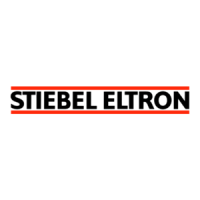
